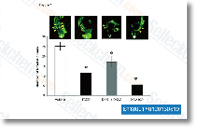Ubiquitin proteasome dependent proteolysis appears to perform a serious role in muscle protein degradation which include greater proteoly sis following denervation. The E3 ubiquitin ligases muscle ring finger protein one and muscle atrophy F box appear to become vital and their mRNA expression levels raise in a amount of diverse atrophic circumstances such as denervation. Enhanced Akt activity continues to be recommended to reduce the expression of MuRF1 and MAFbx based within the means of Akt to phosphorylate Foxo transcription things. In atrophic denervated muscle, nonetheless, unchanged or improved Akt phosphorylation/activity suggests that other signaling mechanisms are of relevance for regulating the expression of MuRF1 and MAFbx in denervated muscle.
Such signaling mechanisms may well contain tumor necrosis component like weak inducer of apoptosis and its receptor, fibroblast growth issue inducible receptor 14, nuclear factor kappaB, heat shock proteins such as Hsp70 and Hsp25rodent/27human and mitogen activated protein kinase activated protein kinase 2, a substrate of p38 MAPK. Conclusions price LY2886721 This examine has examined the hypothesis that Akt/mTOR signaling is elevated in hypertrophic muscle and decreased in atrophic muscle working with a model consisting of different denervated skeletal muscle groups. The outcomes are constant with former studies displaying enhanced Akt/ mTOR signaling in versions of hypertrophic skeletal muscle. In contrast to former studies, on other models of skeletal muscle atrophy, the existing review identified no proof of decreased Akt phosphorylation in atrophic denervated anterior tibial muscle.
The outcomes of the existing research also recommend improved signaling by means of mTOR, indicating improved protein synthesis, in denervated atrophic muscles also as in denervated hypertrophic muscle tissue. Enhanced protein degradation, read full article instead of decreased protein synthesis, is consequently prone to be accountable for the loss of muscle mass in dener vated atrophic muscle tissues. Many of the alterations in protein expression and phosphorylation observed within the existing review could possibly be associated to denervation alterations in skeletal muscle aside from these immediately concerned inside the regulation of muscle mass. Strategies Animals All experiments were performed on grownup male NMRI mice. In advance of surgery the animals have been anaesthetized by inhalation of isoflurane or sevoflurane.
Denervation of the left hind limb or even the left hemidiaphragm was performed by sectioning and removing some mm in the sciatic nerve or phrenic  nerve as described previously. Although nonetheless anaesthetized animals obtained a subcutaneous injection of buprenorphine for analgesia. 6 days after denervation mice have been killed by cervical dislocation. The experimental manipulations are actually approved through the Ethical Committee for Animal Experiments, Linkping, Sweden.
nerve as described previously. Although nonetheless anaesthetized animals obtained a subcutaneous injection of buprenorphine for analgesia. 6 days after denervation mice have been killed by cervical dislocation. The experimental manipulations are actually approved through the Ethical Committee for Animal Experiments, Linkping, Sweden.
CRET Signal
structural genes encode proteins that are not involved in gene regulation.
